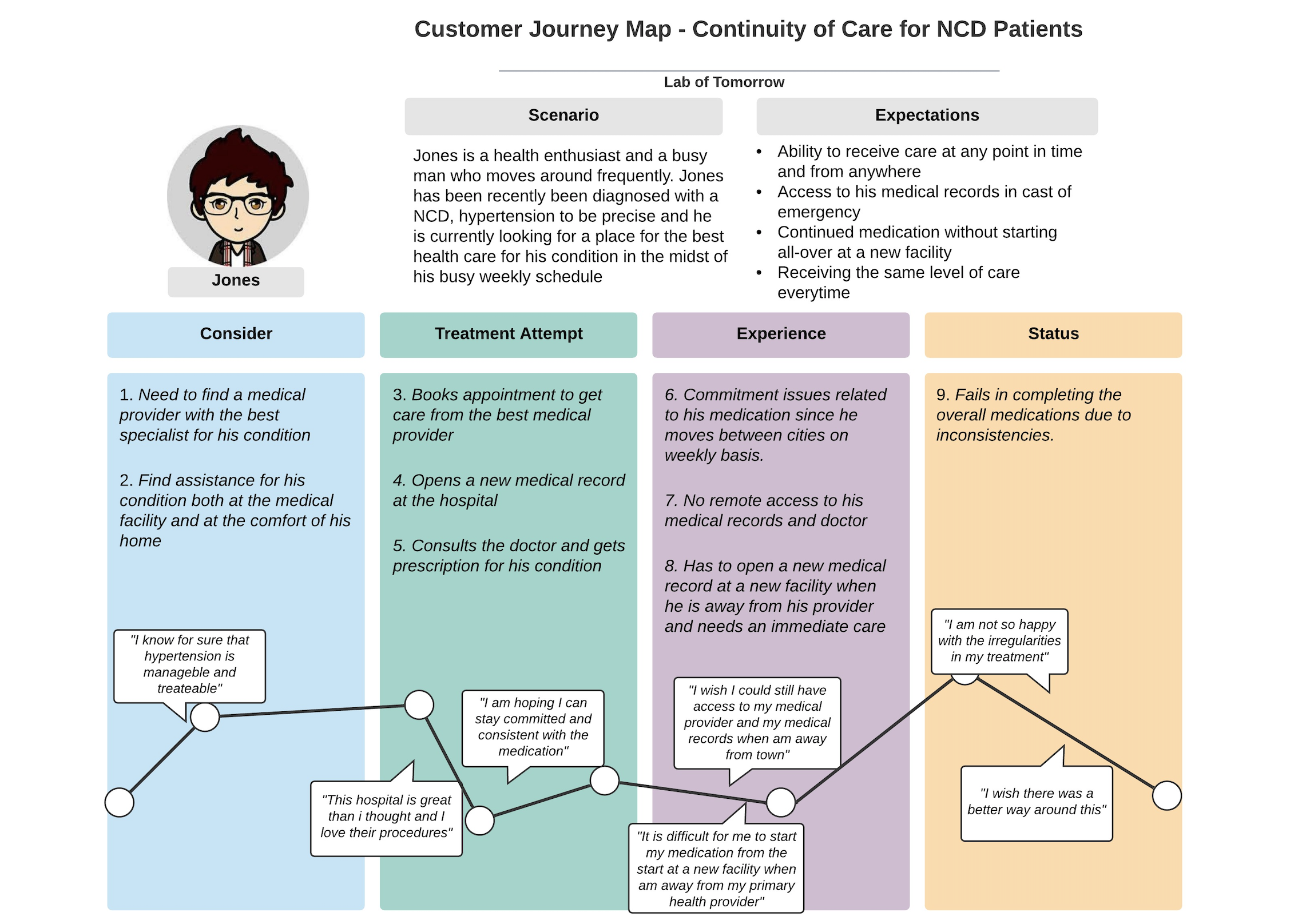Sub Challenge 5
How might we provide seamless access to continuous care at different facilities for NCD patients on the go in a world where access to health facilities and insurance for care is fragmented and not synchronized?
Target Market
The target market for this challenge were NCD patients who are highly mobile due to work or other lifestyle requirements. The market is split between both insured and uninsured patients.
Quotes from Respondents
From interviews concerning access to continuous care
Continuous care is highly needed because it provides constant monitoring for the patients in achieving their desired health goals.
-- Public Health Official
Healthcare is important so access to continuous care could allow everyone to receive the needed care.
-- Nutritionist
Yes, it allows patient’s information to be easily accessed by other facilities for better continuity of care. Other facilities would be able to decipher what exactly has already been done and what needs to be done to help.
-- Nurse
Yes, Absolutely. They need access to continuous care because when one, person transfers from one provider to another, the new provider has access to the previous data and it’ll be valuable in dealing with the case. The continuous data flow is valuable
-- Software Engineer
From interviews concerning dealing with patients with invalid insurance cards
It depends on the facility. Some facilities run a cash-and-carry system whereby without payment, care is not given. Others allow insurance – private or national. Having the NHIS even restricts some levels of access since it does not cover everything. As a practitioner, there is not much you can do. I can only recommend which facility may be able to accommodate the patient in that situation.
-- Medical Doctor
Aside from making them pay cash, there is not much to be done for such patient.
-- Nurse
From experience, usually, when you go to a new system, you are made to register afresh. Sometimes, they may require a transfer of data from your previous provider, but it is not always the case
-- Software Engineer
From interviews concerning the challenges of data synchronization to support continuous care across facilities
1. Financial Barriers
2. Trust Barriers – The knowledge that Client/patient data and records are safe
3. Administrative requirements – IT usability and competence
4. Insecurity. Unstable power supply
-- Medical Doctor
1. Technological advancement in data management
2. Electricity supply
3. Infrastructure: computers, servers, etc.
-- Medical Doctor
1. Human factor – the willingness to build. Facilities must be ready to build the system between each other
2. Willingness to use: Incentive to use the system so the workers can be able to use it well
3. Data and Privacy – The protection of the data of the patients and the assurance that the data won’t be accessed by just anyone.
-- Software Engineer
From interviews concerning the expected benefits of data synchronization across facilities
Easy flow of information on medical care.
-- Public Health Officer
The synchronised system will bring about cost-effectiveness, and allow health workers to become more competent, and lead to improvisation of quality healthcare services. This would also help scale up interventions that have been rolled out to cater for NCD cases and reduce morbidity and mortality of NCD cases.
-- Nutritionist
Can improve NCD patient care. It would ensure clarity of NCDs, and be good for optimisation to make healthcare delivery less stressful and cumbersome. Investment into the future to support clinical research and management of NCDs.
-- Medical Doctor
Unmet Need
From the primary research conducted, the following findings were identified.
It can be concluded that there is an unmet need of having remote access to the medical providers as well as the non-existence of a sychronized systems which permits information flow for the purpose of continuous care for NCD patients.
- Overall, the majority of the respondents are currently not having remote access to their medical provider and/or continuous. 97% of respondents would love to have remote access to their medical provider.
- In addition to this 91% of the respondents also wanted an integrated medical system for the exchange of information between medical providers for the purpose of providing continuous care for NCD patients.
Market Demand
The market demand for the solution determined was determined by the willingness of the respondents to pay for services that provide integration and coordination of their medical information for the purpose of receiving care from their medical providers as well as having remote access to their medical providers.
88% of the respondents are willing to pay for such services in order to receive continuous care and also have remote access to their medical provider.
Most of the respondents, about 97%, are willing to also refer other people to such services even though 12% of the respondents are not willing to pay for the service.
The above is an indication that there is some sort of demand of a continuity of care in a seamless way in Ghana.
Market Constraints
Key Behavioral or Market constraints and challenges identified.
An average of 61% of the respondents confirmed that they do not receive the same level of care from different facilities with their medical insurance. Additionally, their medical insurance does not permit remote access or continuity of care from their current medical provider.
Data and Security Challenges
Commitment from Hospital Administrators
Financial Challenges
Government Policies
Unwillingness of Institution to work together
Logistic Issues
Funding
Network Issues
Trust Barriers
Electricity Supply
Administration requirement for the continuity of care
There are also technical, regulatory and ethical issues that need to be considered. They are as follows:
- Informed consent to use patient data
- Licensing
- Clinical privileges and credentials
- Internet prescribing
- Conflicts of interest
- Malpractice insurance
- Protected health information
Resources
Research data and other useful materials related to this challenge.
